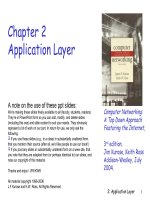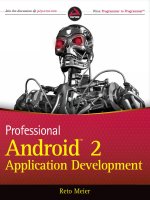Application architectures
Bạn đang xem bản rút gọn của tài liệu. Xem và tải ngay bản đầy đủ của tài liệu tại đây (83.6 KB, 13 trang )
©Ian Sommerville 2004 Software Engineering, 7th edition. Chapter 13 Slide 1
Application architectures
©Ian Sommerville 2004 Software Engineering, 7th edition. Chapter 13 Slide 2
Objectives
To explain the organisation of two fundamental
models of business systems - batch
processing and transaction processing
systems
To describe the abstract architecture of
resource management systems
To explain how generic editors are event
processing systems
To describe the structure of language
processing systems
©Ian Sommerville 2004 Software Engineering, 7th edition. Chapter 13 Slide 3
Topics covered
Data processing systems
Transaction processing systems
Event processing systems
Language processing systems
©Ian Sommerville 2004 Software Engineering, 7th edition. Chapter 13 Slide 4
Generic application architectures
Application systems are designed to meet an
organisational need.
As businesses have much in common, their
application systems also tend to have a
common architecture that reflects the
application requirements.
A generic architecture is configured and
adapted to create a system that meets specific
requirements.
©Ian Sommerville 2004 Software Engineering, 7th edition. Chapter 13 Slide 5
Use of application architectures
As a starting point for architectural design.
As a design checklist.
As a way of organising the work of the
development team.
As a means of assessing components for
reuse.
As a vocabulary for talking about application
types.
©Ian Sommerville 2004 Software Engineering, 7th edition. Chapter 13 Slide 6
Application types
Data processing applications
• Data driven applications that process data in batches
without explicit user intervention during the processing.
Transaction processing applications
• Data-centred applications that process user requests
and update information in a system database.
Event processing systems
• Applications where system actions depend on
interpreting events from the system’s environment.
Language processing systems
• Applications where the users’ intentions are specified in
a formal language that is processed and interpreted by
the system.
©Ian Sommerville 2004 Software Engineering, 7th edition. Chapter 13 Slide 7
Application type examples
Data processing systems
• Billing systems;
• Payroll systems.
Transaction processing systems
• E-commerce systems;
• Reservation systems.
Event processing systems
• Word processors;
• Real-time systems.
Language processing systems
• Compilers;
• Command interpreters.
©Ian Sommerville 2004 Software Engineering, 7th edition. Chapter 13 Slide 8
Data processing systems
Systems that are data-centred where the
databases used are usually orders of
magnitude larger than the software itself.
Data is input and output in batches
• Input: A set of customer numbers and associated
readings of an electricity meter;
• Output: A corresponding set of bills, one for each
customer number.
Data processing systems usually have an
input-process-output structure.
©Ian Sommerville 2004 Software Engineering, 7th edition. Chapter 13 Slide 9
Input-process-output model
System
Input Process Output
Printer
Database
©Ian Sommerville 2004 Software Engineering, 7th edition. Chapter 13 Slide 10
Input-process-output
The input component reads data from a file or
database, checks its validity and queues the
valid data for processing.
The process component takes a transaction
from the queue (input), performs computations
and creates a new record with the results of
the computation.
The output component reads these records,
formats them accordingly and writes them to
the database or sends them to a printer.
©Ian Sommerville 2004 Software Engineering, 7th edition. Chapter 13 Slide 11
Data-flow diagrams
Show how data is processed as it moves
through a system.
Transformations are represented as round-
edged rectangles, data-flows as arrows
between them and files/data stores as
rectangles.
©Ian Sommerville 2004 Software Engineering, 7th edition. Chapter 13 Slide 12
Salary payment DFD
Read employee
record
Read monthly
pay data
Compute
salary
Write tax
transactions
Monthly pay
data
Tax
tables
Tax
transactions
Pension data
Validate
employee data
Write pension
data
Write bank
transaction
Write social
security data
Employee
records
Monthly pay
rates
Bank
transactions
Socialsecurity
data
Print payslip
PRINTER
Decoded
employee
record
Pay information
Valid
employee record
Tax deduction + SS
number+taxoffice
Pension
deduction+
SS number
Empoyee data
+ deductions
Net payment + bank
account info.
Social security
deduction+SSnumber
©Ian Sommerville 2004 Software Engineering, 7th edition. Chapter 13 Slide 13
Transaction processing systems
Process user requests for information from a
database or requests to update the database.
From a user perspective a transaction is:
• Any coherent sequence of operations that satisfies
a goal;
• For example - find the times of flights from London
to Paris.
Users make asynchronous requests for
service which are then processed by a
transaction manager.
©Ian Sommerville 2004 Software Engineering, 7th edition. Chapter 13 Slide 14
Transaction processing
I/O
processing
Application
logic
Transaction
manager
Database
©Ian Sommerville 2004 Software Engineering, 7th edition. Chapter 13 Slide 15
ATM system organisation
Get customer
account id
Validate card
Input
Query account
Updateaccount
Print details
Return card
Dispense cash
Process
Output
Select service
ATM Database ATM









